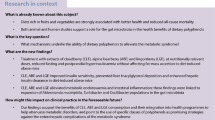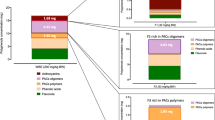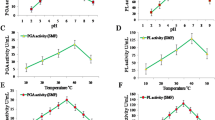Abstract
Purpose
To determine whether the anthocyanin, pelargonidin 3-glucoside (P3G), attenuates symptoms of inflammatory bowel disease (IBD) and metabolic syndrome in rats.
Methods
We tested P3G-enriched strawberry in two models of chronic inflammation in rats, chronic IBD induced by 0.5% dextran sodium sulphate in the drinking water for 12 weeks (D) and metabolic syndrome induced by a high-carbohydrate, high-fat diet (H) for 16 weeks. P3G-enriched strawberry was added to the diet for the final 6 weeks in IBD rats (DP) or 8 weeks in H rats (HP) to provide a dose of 8 mg P3G/kg/day.
Results
D rats had marked diarrhoea, bloody stools, erosion of mucosal epithelium, crypt atrophy, loss of villi and goblet cells, and inflammatory cell infiltration. These symptoms were reversed by P3G with healthy stools and mucosal lining of ileum and colon including increased villi, crypts and goblet cells and reduced inflammation. H rats developed hypertension, dyslipidaemia, central obesity, increased ventricular stiffness, cardiac and liver inflammation, and steatosis. P3G treatment in H rats improved systolic blood pressure, ventricular stiffness, and cardiac and liver structure, and reduced abdominal fat, abdominal circumference and body weight gain.
Conclusions
Our study indicates that dietary P3G decreased inflammation to decrease the symptoms of IBD, and to improve cardiovascular, liver and metabolic functions in metabolic syndrome.





Similar content being viewed by others
References
Brown L, Poudyal H, Panchal SK (2015) Functional foods as potential therapeutic options for metabolic syndrome. Obes Rev 16(11):914–941. https://doi.org/10.1111/obr.12313
Ghattamaneni NKR, Panchal SK, Brown L (2018) Nutraceuticals in rodent models as potential treatments for human Inflammatory Bowel Disease. Pharmacol Res 132:99–107. https://doi.org/10.1016/j.phrs.2018.04.015
Wu GD (2014) Diet, the gut microbiome and the metabolome in IBD. Nestle Nutr Inst Workshop Ser 79:73–82. https://doi.org/10.1159/000360686
Bernstein CN, Fried M, Krabshuis JH, Cohen H, Eliakim R, Fedail S, Gearry R, Goh KL, Hamid S, Khan AG, LeMair AW, Malfertheiner Ouyang Q, Rey JF, Sood A, Steinwurz F, Thomsen OO, Thomson A, Watermeyer G (2010) World Gastroenterology Organization practice guidelines for the diagnosis and management of IBD in 2010. Inflamm Bowel Dis 16(1):112–124. https://doi.org/10.1002/ibd.21048
Samson SL, Garber AJ (2014) Metabolic syndrome. Endocrinol Metab Clin North Am 43(1):1–23. https://doi.org/10.1016/j.ecl.2013.09.009
Naseri R, Farzaei F, Haratipour P, Nabavi SF, Habtemariam S, Farzaei MH, Khodarahmi R, Tewari D, Momtaz S (2018) Anthocyanins in the management of metabolic syndrome: a pharmacological and biopharmaceutical review. Front Pharmacol 9:1310. https://doi.org/10.3389/fphar.2018.01310
Basu A, Nguyen A, Betts NM, Lyons TJ (2014) Strawberry as a functional food: an evidence-based review. Crit Rev Food Sci Nutr 54(6):790–806. https://doi.org/10.1080/10408398.2011.608174
Afrin S, Gasparrini M, Forbes-Hernandez TY, Reboredo-Rodriguez P, Mezzetti B, Varela-Lopez A, Giampieri F, Battino M (2016) Promising health benefits of the strawberry: a focus on clinical studies. J Agric Food Chem 64(22):4435–4449. https://doi.org/10.1021/acs.jafc.6b00857
Edirisinghe I, Burton-Freeman B, Varelis P, Kappagoda T (2008) Strawberry extract caused endothelium-dependent relaxation through the activation of PI3 kinase/Akt. J Agric Food Chem 56(20):9383–9390. https://doi.org/10.1021/jf801864t
Vendrame S, Klimis-Zacas D (2015) Anti-inflammatory effect of anthocyanins via modulation of nuclear factor-κB and mitogen-activated protein kinase signaling cascades. Nutr Rev 73(6):348–358. https://doi.org/10.1093/nutrit/nuu066
Fredericks CH, Fanning KJ, Gidley MJ, Netzel G, Zabaras D, Herrington M, Netzel M (2013) High-anthocyanin strawberries through cultivar selection. J Sci Food Agric 93(4):846–852. https://doi.org/10.1002/jsfa.5806
Kanodia L, Borgohain M, Das S (2011) Effect of fruit extract of Fragaria vesca L. on experimentally induced inflammatory bowel disease in albino rats. Indian J Pharmacol 43(1):18–21. https://doi.org/10.4103/0253-7613.75660
Fang J (2015) Classification of fruits based on anthocyanin types and relevance to their health effects. Nutrition 31(11–12):1301–1306. https://doi.org/10.1016/j.nut.2015.04.015
Sodagari HR, Farzaei MH, Bahramsoltani R, Abdolghaffari AH, Mahmoudi M, Rezaei N (2015) Dietary anthocyanins as a complementary medicinal approach for management of inflammatory bowel disease. Expert Rev Gastroenterol Hepatol 9(6):807–820. https://doi.org/10.1586/17474124.2015.1002086
Fang J (2014) Bioavailability of anthocyanins. Drug Metab Rev 46(4):508–520. https://doi.org/10.3109/03602532.2014.978080
Ghattamaneni NKR, Panchal SK, Brown L (2019) Cyanidin 3-glucoside from Queen Garnet plums and purple carrots attenuates DSS-induced inflammatory bowel disease in rats. J Funct Foods 56:194–203. https://doi.org/10.1016/j.jff.2019.01.028
Bhaswant M, Fanning K, Netzel M, Mathai ML, Panchal SK, Brown L (2015) Cyanidin 3-glucoside improves diet-induced metabolic syndrome in rats. Pharmacol Res 102:208–217. https://doi.org/10.1016/j.phrs.2015.10.006
Bhaswant M, Shafie SR, Mathai ML, Mouatt P, Brown L (2017) Anthocyanins in chokeberry and purple maize attenuate diet-induced metabolic syndrome in rats. Nutrition 41:24–31. https://doi.org/10.1016/j.nut.2016.12.009
Ichiyanagi T, Kashiwada Y, Shida Y, Sekiya M, Hatano Y, Takaishi Y, Ikeshiro Y (2013) Structural elucidation and biological fate of two glucuronyl metabolites of pelargonidin 3-O-β-d-glucopyranoside in rats. J Agric Food Chem 61(3):569–578. https://doi.org/10.1021/jf3032793
Ghattamaneni NKR, Panchal SK, Brown L (2018) An improved rat model for chronic inflammatory bowel disease. Pharmacol Rep 71(1):149–155. https://doi.org/10.1016/j.pharep.2018.10.006
Giampieri F, Alvarez-Suarez JM, Battino M (2014) Strawberry and human health: effects beyond antioxidant activity. J Agric Food Chem 62(18):3867–3876. https://doi.org/10.1021/jf405455n
Panchal SK, Poudyal H, Iyer A, Nazer R, Alam MA, Diwan V, Kauter K, Sernia C, Campbell F, Ward L, Gobe G, Fenning A, Brown L (2011) High-carbohydrate, high-fat diet-induced metabolic syndrome and cardiovascular remodeling in rats. J Cardiovasc Pharmacol 57(5):611–624. https://doi.org/10.1097/FJC.0b013e31821b1379
Sekar S, Shafie SR, Prasadam I, Crawford R, Panchal SK, Brown L, Xiao Y (2017) Saturated fatty acids induce development of both metabolic syndrome and osteoarthritis in rats. Sci Rep 7:46457. https://doi.org/10.1038/srep46457
John OD, Mouatt P, Prasadam I, Xiao Y, Panchal SK, Brown L (2019) The edible native Australian fruit, Davidson’s plum (Davidsonia pruriens), reduces symptoms in rats with diet-induced metabolic syndrome. J Funct Foods 56:204–215. https://doi.org/10.1016/j.jff.2019.03.018
Parlee SD, Lentz SI, Mori H, MacDougald OA (2014) Quantifying size and number of adipocytes in adipose tissue. Methods Enzymol 537:93–122. https://doi.org/10.1016/B978-0-12-411619-1.00006-9s
Vasina V, Broccoli M, Ursino MG, Canistro D, Valgimigli L, Soleti A, Paolini M, De Ponti F (2010) Non-peptidyl low molecular weight radical scavenger IAC attenuates DSS-induced colitis in rats. World J Gastroenterol 16(29):3642–3650. https://doi.org/10.3748/wjg.v16.i29.3642
Li D, Wang P, Luo Y, Zhao M, Chen F (2017) Health benefits of anthocyanins and molecular mechanisms: update from recent decade. Crit Rev Food Sci Nutr 57(8):1729–1741. https://doi.org/10.1080/10408398.2015.1030064
Poudyal H, Panchal S, Brown L (2010) Comparison of purple carrot juice and β-carotene in a high-carbohydrate, high-fat diet-fed rat model of the metabolic syndrome. Br J Nutr 104(9):1322–1332. https://doi.org/10.1017/s0007114510002308
Yan Y, Kolachala V, Dalmasso G, Nguyen H, Laroui H, Sitaraman SV, Merlin D (2009) Temporal and spatial analysis of clinical and molecular parameters in dextran sodium sulfate induced colitis. PLoS One 4(6):e6073. https://doi.org/10.1371/journal.pone.0006073
Farzaei MH, Bahramsoltani R, Abdolghaffari AH, Sodagari HR, Esfahani SA, Rezaei N (2016) A mechanistic review on plant-derived natural compounds as dietary supplements for prevention of inflammatory bowel disease. Expert Rev Gastroenterol Hepatol 10(6):745–758. https://doi.org/10.1586/17474124.2016.1145546
Alipour M, Zaidi D, Valcheva R, Jovel J, Martinez I, Sergi C, Walter J, Mason AL, Wong GK, Dieleman LA, Carroll MW, Huynh HQ, Wine E (2016) Mucosal barrier depletion and loss of bacterial diversity are primary abnormalities in paediatric ulcerative colitis. J Crohns Colitis 10(4):462–471. https://doi.org/10.1093/ecco-jcc/jjv223
Moran CJ, Walters TD, Guo CH, Kugathasan S, Klein C, Turner D, Wolters VM, Bandsma RH, Mouzaki M, Zachos M, Langer JC, Cutz E, Benseler SM, Roifman CM, Silverberg MS, Griffiths AM, Snapper SB, Muise AM (2013) IL-10R polymorphisms are associated with very-early-onset ulcerative colitis. Inflamm Bowel Dis 19(1):115–123. https://doi.org/10.1002/ibd.22974
Amini AM, Muzs K, Spencer JP, Yaqoob P (2017) Pelargonidin-3-O-glucoside and its metabolites have modest anti-inflammatory effects in human whole blood cultures. Nutr Res 46:88–95. https://doi.org/10.1016/j.nutres.2017.09.006
Farzaei MH, El-Senduny FF, Momtaz S, Parvizi F, Iranpanah A, Tewari D, Naseri R, Abdolghaffari AH, Rezaei N (2018) An update on dietary consideration in inflammatory bowel disease: anthocyanins and more. Expert Rev Gastroenterol Hepatol 12(10):1007–1024. https://doi.org/10.1080/17474124.2018.1513322
Yang G, Wang H, Kang Y, Zhu MJ (2014) Grape seed extract improves epithelial structure and suppresses inflammation in ileum of IL-10-deficient mice. Food Funct 5(10):2558–2563. https://doi.org/10.1039/c4fo00451e
Pandurangan AK, Saadatdoust Z, Esa NM, Hamzah H, Ismail A (2015) Dietary cocoa protects against colitis-associated cancer by activating the Nrf2/Keap1 pathway. BioFactors 41(1):1–14. https://doi.org/10.1002/biof.1195
Biagioli M, Carino A, Fiorucci C, Annunziato G, Marchiano S, Bordoni M, Roselli R, Giorgio CD, Castiglione F, Ricci P, Bruno A, Faccini A, Distrutti E, Baldoni M, Costantino G, Fiorucci S (2019) The aryl hydrocarbon receptor (AhR) mediates the counter-regulatory effects of pelargonidins in models of inflammation and metabolic dysfunctions. Nutrients 11(8):1820. https://doi.org/10.3390/nu11081820
Putta S, Yarla NS, Kumar EK, Lakkappa DB, Kamal MA, Scotti L, Scotti MT, Ashraf GM, Barreto GE, Rao BSB, Kumari DS, Reddy GV, Tarasov VV, Imandi SB, Aliev G (2017) Preventive and therapeutic potentials of anthocyanins in diabetes and associated complications. Curr Med Chem 25(39):5347–5371. https://doi.org/10.2174/0929867325666171206101945
Petersen C, Bharat D, Cutler BR, Gholami S, Denetso C, Mueller JE, Cho JM, Kim JS, Symons JD, Anandh Babu PV (2018) Circulating metabolites of strawberry mediate reductions in vascular inflammation and endothelial dysfunction in db/db mice. Int J Cardiol 263:111–117. https://doi.org/10.1016/j.ijcard.2018.04.040
Amani R, Moazen S, Shahbazian H, Ahmadi K, Jalali MT (2014) Flavonoid-rich beverage effects on lipid profile and blood pressure in diabetic patients. World J Diabetes 5(6):962–968. https://doi.org/10.4239/wjd.v5.i6.962
Cassidy A, O’Reilly EJ, Kay C, Sampson L, Franz M, Forman JP, Curhan G, Rimm EB (2011) Habitual intake of flavonoid subclasses and incident hypertension in adults. Am J Clin Nutr 93(2):338–347. https://doi.org/10.3945/ajcn.110.006783
Cassidy A, Mukamal KJ, Liu L, Franz M, Eliassen AH, Rimm EB (2013) High anthocyanin intake is associated with a reduced risk of myocardial infarction in young and middle-aged women. Circulation 127(2):188–196. https://doi.org/10.1161/CIRCULATIONAHA.112.122408
Ellis CL, Edirisinghe I, Kappagoda T, Burton-Freeman B (2011) Attenuation of meal-induced inflammatory and thrombotic responses in overweight men and women after 6-week daily strawberry (Fragaria) intake. A randomized placebo-controlled trial. J Atheroscler Thromb 18(4):318–327. https://doi.org/10.5551/jat.6114
Aranaz P, Romo-Hualde A, Zabala M, Navarro-Herrera D, Ruiz de Galarreta M, Gil AG, Martinez JA, Milagro FI, Gonzalez-Navarro CJ (2017) Freeze-dried strawberry and blueberry attenuates diet-induced obesity and insulin resistance in rats by inhibiting adipogenesis and lipogenesis. Food Funct 8(11):3999–4013. https://doi.org/10.1039/c7fo00996h
Jiang X, Li X, Zhu C, Sun J, Tian L, Chen W, Bai W (2019) The target cells of anthocyanins in metabolic syndrome. Crit Rev Food Sci Nutr 59(6):921–946. https://doi.org/10.1080/10408398.2018.1491022
Wu T, Yin J, Zhang G, Long H, Zheng X (2016) Mulberry and cherry anthocyanin consumption prevents oxidative stress and inflammation in diet-induced obese mice. Mol Nutr Food Res 60(3):687–694. https://doi.org/10.1002/mnfr.201500734
Arjinajarn P, Chueakula N, Pongchaidecha A, Jaikumkao K, Chatsudthipong V, Mahatheeranont S, Norkaew O, Chattipakorn N, Lungkaphin A (2017) Anthocyanin-rich riceberry bran extract attenuates gentamicin-induced hepatotoxicity by reducing oxidative stress, inflammation and apoptosis in rats. Biomed Pharmacother 92:412–420. https://doi.org/10.1016/j.biopha.2017.05.100
Shafie SR, Wanyonyi S, Panchal SK, Brown L (2019) Linseed components are more effective than whole linseed in reversing diet-induced metabolic syndrome in rats. Nutrients 11(7):1677. https://doi.org/10.3390/nu11071677
Alvarez-Suarez JM, Giampieri F, Tulipani S, Casoli T, Di Stefano G, Gonzalez-Paramas AM, Santos-Buelga C, Busco F, Quiles JL, Cordero MD, Bompadre S, Mezzetti B, Battino M (2014) One-month strawberry-rich anthocyanin supplementation ameliorates cardiovascular risk, oxidative stress markers and platelet activation in humans. J Nutr Biochem 25(3):289–294. https://doi.org/10.1016/j.jnutbio.2013.11.002
Prior RL, Wu X, Gu L, Hager T, Hager A, Wilkes S, Howard L (2009) Purified berry anthocyanins but not whole berries normalize lipid parameters in mice fed an obesogenic high fat diet. Mol Nutr Food Res 53(11):1406–1418. https://doi.org/10.1002/mnfr.200900026
Jamar G, Estadella D, Pisani LP (2017) Contribution of anthocyanin-rich foods in obesity control through gut microbiota interactions. BioFactors 43(4):507–516. https://doi.org/10.1002/biof.1365
Park E, Edirisinghe I, Wei H, Vijayakumar LP, Banaszewski K, Cappozzo JC, Burton-Freeman B (2016) A dose-response evaluation of freeze-dried strawberries independent of fiber content on metabolic indices in abdominally obese individuals with insulin resistance in a randomized, single-blinded, diet-controlled crossover trial. Mol Nutr Food Res 60(5):1099–1109. https://doi.org/10.1002/mnfr.201500845
Paquette M, Medina Larque AS, Weisnagel SJ, Desjardins Y, Marois J, Pilon G, Dudonne S, Marette A, Jacques H (2017) Strawberry and cranberry polyphenols improve insulin sensitivity in insulin-resistant, non-diabetic adults: a parallel, double-blind, controlled and randomised clinical trial. Br J Nutr 117(4):519–531. https://doi.org/10.1017/S0007114517000393
Miller K, Feucht W, Schmid M (2019) Bioactive compounds of strawberry and blueberry and their potential health effects based on human intervention studies: a brief overview. Nutrients 11(7):1510. https://doi.org/10.3390/nu11071510
Lee YM, Yoon Y, Yoon H, Park HM, Song S, Yeum KJ (2017) Dietary anthocyanins against obesity and inflammation. Nutrients 9(10):1089. https://doi.org/10.3390/nu9101089
Kim SY, Wi H-R, Choi S, Ha TJ, Lee BW, Lee M (2015) Inhibitory effect of anthocyanin-rich black soybean testa (Glycine max (L.) Merr.) on the inflammation-induced adipogenesis in a DIO mouse model. J Funct Foods 14:623–633. https://doi.org/10.1016/j.jff.2015.02.030
Yook JS, Kim KA, Kim M, Cha YS (2017) Black Adzuki bean (Vigna angularis) attenuates high-fat diet-induced colon inflammation in mice. J Med Food 20(4):367–375. https://doi.org/10.1089/jmf.2016.3821
Wu X, Pittman HE 3rd, Prior RL (2004) Pelargonidin is absorbed and metabolized differently than cyanidin after marionberry consumption in pigs. J Nutr 134(10):2603–2610. https://doi.org/10.1093/jn/134.10.2603
Fang J (2014) Some anthocyanins could be efficiently absorbed across the gastrointestinal mucosa: extensive presystemic metabolism reduces apparent bioavailability. J Agric Food Chem 62(18):3904–3911. https://doi.org/10.1021/jf405356b
Warner EF, Rodriguez-Ramiro I, O’Connell MA, Kay CD (2018) Cardiovascular mechanisms of action of anthocyanins may be associated with the impact of microbial metabolites on heme oxygenase-1 in vascular smooth muscle cells. Molecules 23(4):898. https://doi.org/10.3390/molecules23040898
Krga I, Tamaian R, Mercier S, Boby C, Monfoulet LE, Glibetic M, Morand C, Milenkovic D (2018) Anthocyanins and their gut metabolites attenuate monocyte adhesion and transendothelial migration through nutrigenomic mechanisms regulating endothelial cell permeability. Free Radic Biol Med 124:364–379. https://doi.org/10.1016/j.freeradbiomed.2018.06.027
Reagan-Shaw S, Nihal M, Ahmad N (2008) Dose translation from animal to human studies revisited. FASEB J 22(3):659–661. https://doi.org/10.1096/fj.07-9574LSF
Acknowledgement
Rat urine samples were analysed for sugars at the Central Analytical Research Facility (CARF) of the Queensland University of Technology, Gardens Point, Brisbane, with the assistance of Dr. Rajesh Gupta. Gut histology was performed at the CARF, Queensland University of Technology, Kelvin Grove, Brisbane, with the assistance of Ms Felicity Lawrence. We thank Brian Bynon, School of Veterinary Sciences, The University of Queensland, Gatton, for the plasma analyses. This work was supported by funding received from the University of Southern Queensland Research and Innovation Division.
Author information
Authors and Affiliations
Contributions
NKRG, SKP and LB developed the original study aims. NKRG and AS conducted the experiments. NKRG and AS analysed the data whereas NKRG, SKP and LB interpreted the data; NKRG, SKP and LB prepared manuscript drafts and contributed to the final version. LB has been the corresponding author throughout the writing process. All authors read and approved the final manuscript.
Corresponding author
Ethics declarations
Conflicts of interest
The authors declare no conflicts of interest.
Electronic supplementary material
Below is the link to the electronic supplementary material.
Rights and permissions
About this article
Cite this article
Ghattamaneni, N.K., Sharma, A., Panchal, S.K. et al. Pelargonidin 3-glucoside-enriched strawberry attenuates symptoms of DSS-induced inflammatory bowel disease and diet-induced metabolic syndrome in rats. Eur J Nutr 59, 2905–2918 (2020). https://doi.org/10.1007/s00394-019-02130-1
Received:
Accepted:
Published:
Issue Date:
DOI: https://doi.org/10.1007/s00394-019-02130-1




